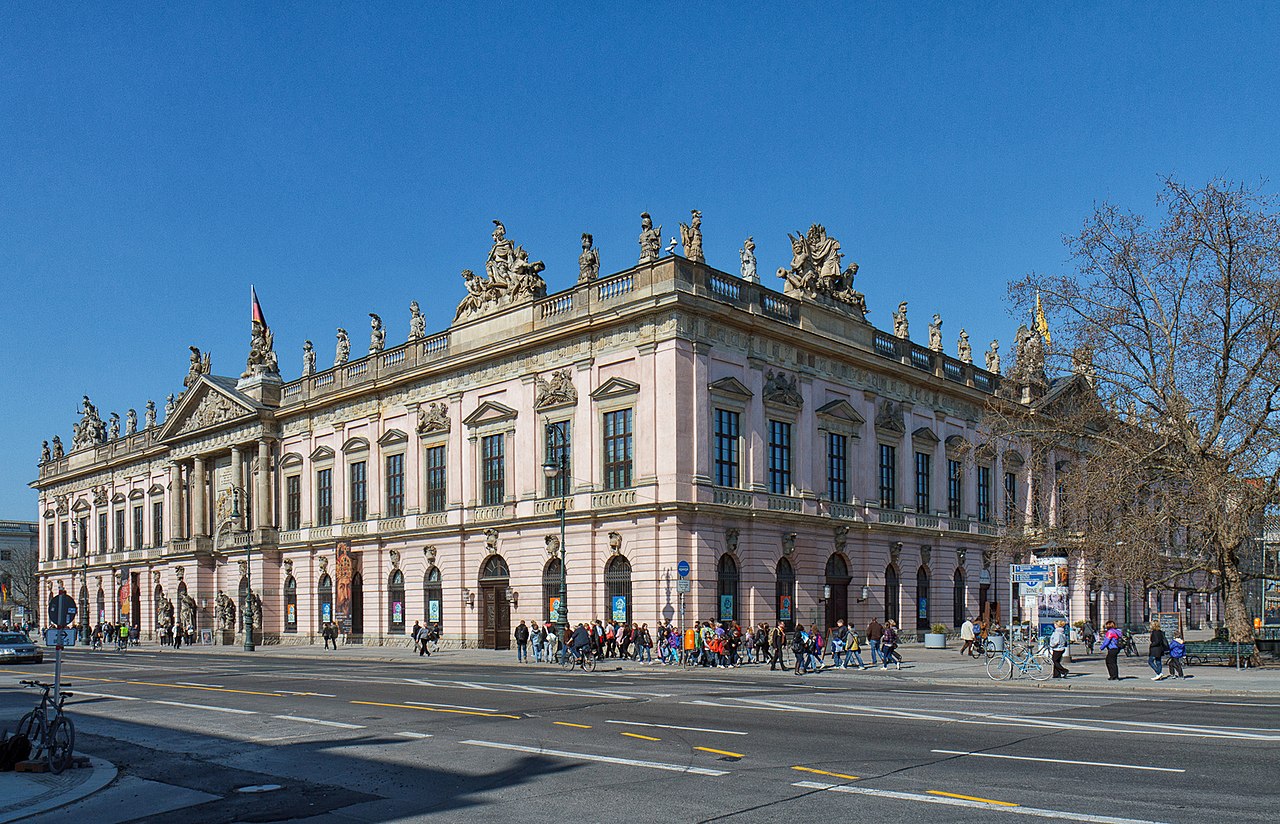Ei ihan museosaarella muttei kovin kaukanakaan, Saksan historian museo (Deutches historisches museum) sijaitsi heti joen vastarannalla. Omien sanojensa mukaan Saksan historian museo tarjoaa katsauksen maan 1500 vuoden historiaan. Keskiajan
museotarjonta oli ollut tähän asti vähän köykäistä, joten toive oli
josko Saksan historian museo olisi tarjonnut sitä lajia enemmän kuin museot joita oli tähän asti nähty. No, jonkin
verran sitä olikin mutta monta vuosisataa sai museossa silti aika nopean
käsittelyn...
Not quite in the museum island but in its immediate surroundings, the Museum of German history (Deutches Historisches Museum) was located just across the river. According to the museum they provide a look to the 1500 years of the history of Germany. In the previous museums where we visited the medieval period was dealt with really quickly, so we were kind of hoping that this museum would be more generous in the presentation of medieval stuff. Well, there was some but considering how many centuries the medieval period covers, I still think it was quite briefly presented...
 |
| Museorakennus ~~~ Museum building, kuva/photo Wikipedia |
Museo oli kahdessa kerroksessa, josta ylempi kerros esitteli ajanjaksoa 500-luvulta ensimmäiseen maailmansotaan. Pohjakerroksessa olisi ollut sitten uudempaa historiaa Weimarin tasavallasta 1990-luvulle. Tässä tapauksessa keskityttiin kakkoskerroksen tarjontaan, uudempi ei ollut niinkään kummankaan reissaajan ykkösprioriteeteissa (ja tiedossa oli vielä visiitti DDR-museoon myöhemmin, mutta siitä sitten enemmän omassa postauksessaan). Ja kyllähän pelkästään yhdessäkin kerroksessa aikaa sai menemään, aivan valtava rakennus kun oli kyseessä.
The museum was in two floors, the upper one covered the period from the 6th century to the first world war. Lower floor, then again, focused on newer history, from the Weimar republic to the 1990s. We focused on the upper floor and older history, since neither of us were so super interested in newer events (and we were going to see the DDR museum later, but more of that in another post). In this case in one floor there was quite a lot to see and it took quite some time, it indeed is a huge building.
 |
Kaarle Suuren patsas, 1100-lukua ~~~ Statue of Charlemagne, 12th century
|
 |
| Slaavilaisperäistä arkiesineistöä Spandausta 800-1100-luvuilta. ~~~ Slavic items from Spandau, 9th-11th centuries. Kuva/photo M. Pulla. |
 |
| Harvinaisempi ihmispään mallinen akvamaniili 1270-luvulta. ~~~ A rare type of aquamanile in the shape of a human head, 1270s. Kuva/photo M. Pulla |
 |
| Akvamaniili Kölnistä 1300-luvulta. ~~ Aquamanile from Cologne, 14th century- Kuva/photo M. Pulla |
 |
Kölnin kaupungin säilytysarkku, 1300-luku ~~~ Storage chest belonging to the town of Cologne, 14th century
|
 |
Kierrätystä noin v. 1300: rikkoutuneesta kolmijalkaruukusta siivilä. ~~~ 14th century recycling: Broken tripod pot turned to a sieve.
|
 |
| Seinävaate jossa kohtauksia neitsyt Marian elämästä, n. 1480 ~~~ Wall hanging with scenes of the life of virgin Mary, c. 1480 |
Keskiajan jälkeisiltä vuosisadoilta olikin sitten varsin reippaasti esineistöä esillä. 1500-luku painottui teemaltaan reformaatioon ja siitä kohtuullisen erottamattamattomaan valtakähinään.
After the medieval period the exhibition progressed somewhat century by century. 16th century part was focused on the important themes of the era, reformation and the power struggles that came with it.
 |
| Patriisipariskunnan muotokuvat, 1550-luku. ~~~ Portraits of a partician couple, 1550s |
 |
| Liikuteltava käsiproteesi, Grüningenin linna, 1500-luku ~~~ Prosthetic arm with moving joints, Grüningen castle, 16th century |
 |
| 1630-luvun maalaus Mühlbergin taistelusta v. 1547 ~~~~ 1630s painting of the battele of Mühlberg in 1547 |
Siinä missä keskiajan ja vielä 1500-luvunkin esineistö oli varsin tukevasti saksalaista, tämän jälkeen osansa saivat myös yhä laajemmalle ulottuvat yhdeydet. Sota oli myös kohtuullisessa roolissa näissä yhteyksissä. Seinäpinta-alasta melkoisen osan ottivat valtavan suuret maalaukset.
Where the items in the medieval and 16th century parts of the exhibition were almost exclusively German of origin, after that it was apparent that Germany too got more widely connected with the rest of the world. Warfare was also a part of those connections... Walls in this part of the exhibition were covered with huge portraits.
 |
| Ruttolääkärin maski 1600-luvulta. Ei siis keskiaikaa nähnytkään. ~~~~ Plague doctor's mask, 17th century. Definitely not medieval! Kuva/photo M. Pulla |
 |
| Sotasaaliiksi saatu turkkilainen teltta 1600-luvun lopulta. Nyt pahasti haalistunut, alkuperäinen teltan väri on ollut kirkas turkoosi vuoritettuna punaisella! ~~~~ Late 17th century Turkish tent, once a war booty. Nowadays the colour is faded, originally it was bright teal lined with red! Kuva/photo M. Pulla |
 |
| Preussin kuningas Fiedrich II:n univormu, 1786 ~~~ Unifom belonging to Preussian king Friedrich II, 1786 |
1800-luvun osastolla huomio kiinnittyi ensisijaisesti vaatteisiin ja tekstiileihin. Niitä olikin esillä runsain määrin!
In the 19th century exhibition there was a significant number of clothing and textiles on display.
 |
| Kukkakirjottu puuvillamekko, 1795-1800 ~~~~ Cotton dress with flower embroidery, 1795-1800 |
 |
| Tekstiilimallikirja painokuvioista käsinkirjoitetuin kommentein, 1807 ~~~~ Textile samples book with handwritten comments, 1807 |
1800-luvun osastolla osansa sai myös teollistuminen, josta sitäkin oli tekstiilipuolen edustus. Siitä eteenpäin ylemmän näyttelykerroksen tarjonta olikin varsin sotilaallista.
Industrialization was a notable part of the 19th century exhibition, and textile industry was a big business and an important part. Apart from that, the latter part of the upper floor exhibition was quite military-themed.
 |
| Langan kertauslaite ~~~ Device for plying yarn |
Museon kotisivut
Museum homepage





















No comments:
Post a Comment